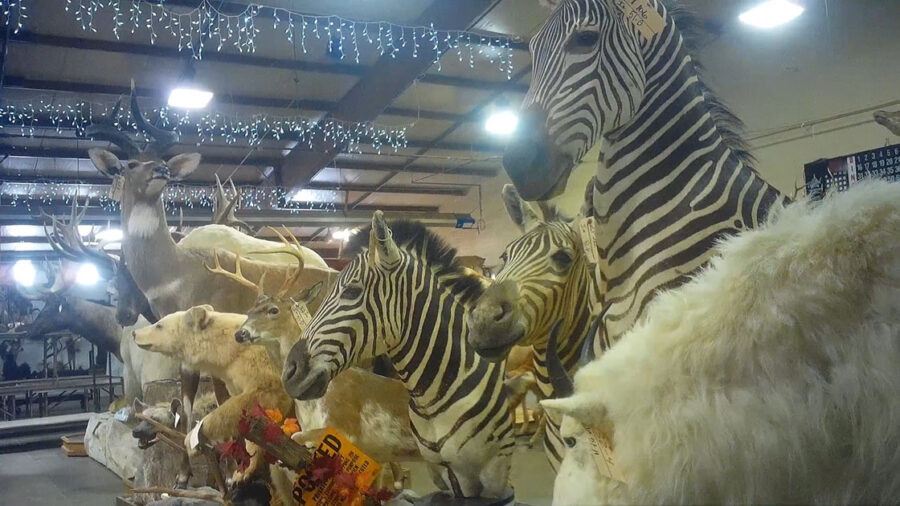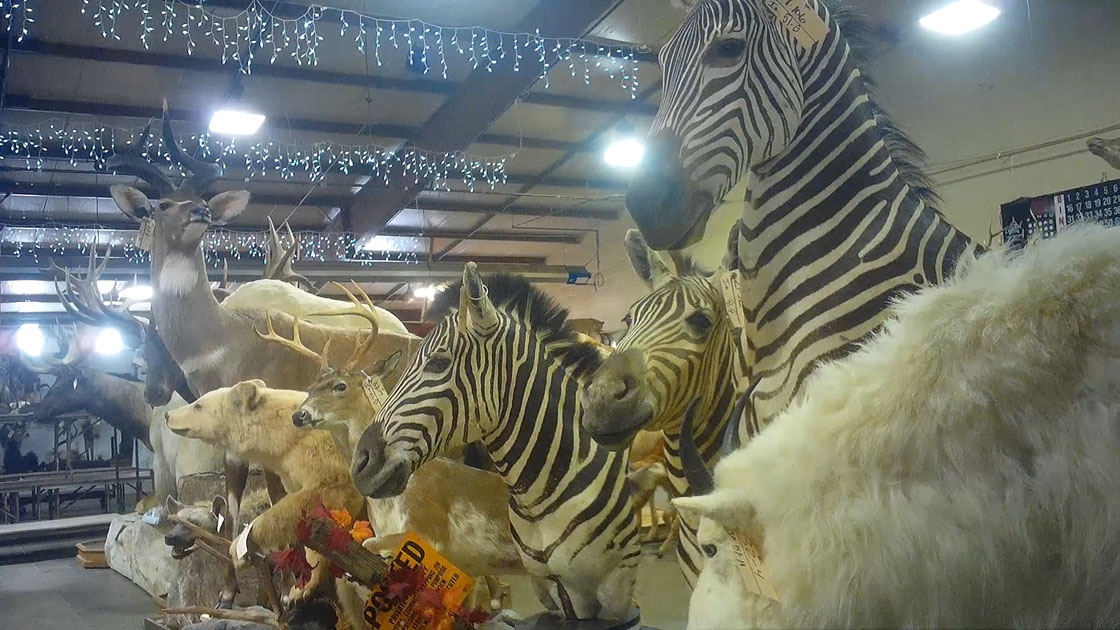
Undercover Investigation Exposes Auction ‘House of Horrors’ Inc. African Hunting Trophies
Cape Town (Nov. 4, 2021) – A shocking undercover investigation recently conducted in Iowa, USA, by Humane Society International (HSI)and the Humane Society of the United States found what they say can only be described as a “massive garbage bin of the trophy hunting industry”. A four-day event was held where thousands of taxidermised animals […]

Cape Town (Nov. 4, 2021) – A shocking undercover investigation recently conducted in Iowa, USA, by Humane Society International (HSI)and the Humane Society of the United States found what they say can only be described as a “massive garbage bin of the trophy hunting industry”.
A four-day event was held where thousands of taxidermised animals – including at least 557 hunting trophies of mammals no longer wanted by the people who killed them – were sold to the highest bidders. Shelves and bins were apparently packed with discarded trophies including threatened and endangered species like elephants and polar bears, other imperiled species like giraffes and hippos, and countless trophies of American wildlife like grizzly bears, black bears and mountain lions.


Auction items included grotesque home décor such as tables and lamps made from giraffe legs and feet, tables made from African elephant feet and a juvenile giraffe taxidermy. The auction also included at least 50 rugs made from animals including black bears, grizzly bears, zebras, wolves and mountain lions. The investigator saw piles of giraffe leg bones, sets of hippo teeth and a dusty box labelled “elephant ears and skin.”


Kitty Block, president and CEO of the Humane Society of the United States, said:
“It is unconscionable that not only are these threatened and endangered species of wild animals killed by trophy hunters, but the souvenirs from these hunts are ultimately mothballed and sold off at a fairground full of unwanted animal body parts. This massive display of animal death is a devastating snapshot of what it looks like when species are being pushed to the brink of extinction.”
The undercover investigator learned that most of the trophies are the result of trophy hunters tiring of their collections, downsizing or dying and leaving these items to family members who don’t want them. One auction staffer said, “Realtors tell homeowners to get rid of those dead critters,” when staging their houses for sale.
Trophies at the auction include:
- Four African elephant feet made into tables with elephant skin tops. According to the International Union for the Conservation of Nature, the African savanna elephant is endangered, and the African forest elephant is critically endangered. The African elephant is listed as threatened under the U.S. Endangered Species Act.

- Two hollowed elephant feet which auction organizers suggest “would make a nice trash can.”
- A polar bear (considered vulnerable by IUCN and listed as threatened under the ESA) with a ringed seal sold for $26,000, the highest price of the trophies sold at the auction.
- Four giraffe legs made into a matching set coffee table and floor lamp.
- A large cardboard box labelled “elephant ears and skin.”
- Two giraffe skulls and three full giraffe bodies (IUCN vulnerable) including a baby promoted as “the perfect size that can go in about any room in the house,” sold for $6,200.
- Giraffe leg bones promoted as “great for crafts.”
- A hippo skull and two hippo (IUCN vulnerable) shoulder mounts (head, neck, shoulders).
- Two sets of hippo teeth.

- Baby zebra taxidermy, six zebra skins and rugs including one from a calf, and several zebra heads for “tabletop display.”\
- Six monkeys, including a stuffed vervet holding a beer bottle.
- Two baby and one adult baboon.
- 49 bears including five cubs and a mother-cub pair.
- 18 rugs made from grizzly bears or black bears.
- Bear claws promoted as “great for jewelry or crafts.”
- Seven bobcats, including two rugs.
- Four wolves, including two rugs.
- Eight mountain lions, including two rugs.
Jeffrey Flocken, president of Humane Society International, said:
“It is deeply saddening to see this final stage of the trophy hunting industry where these majestic species are relegated to an auction house floor instead of fulfilling their role in their respective populations and ecosystems.”
South African-Related Facts Regarding Trophies:
- South Africa is the second largest exporter of trophies of CITES-listed species globally, and the largest such exporter in Africa. South Africa reported exporting a total of 21,018 trophies between 2014 – 2018, average 4204 per year (CITES)
- There are about 68,000 mature giraffes remaining in the wild, and the population is still declining, but more than 40,000 giraffe parts and products were imported into the U.S. between 2006 and 2015.
- The population of African savanna elephants decreased by at least 60% over the last 50 years, yet according to international trade data, American trophy hunters have imported over 700 trophies and 399 tusks from African elephants between 2014 and 2018.
- Hippo populations are vulnerable; additional pressure from trophy hunters and for international commercial trade in ivory may lead to population decline, yet according to international trade data, hunting trophies and other parts from 2,500 hippos were imported into the U.S. between 2009 and 2018.
WATCH Extinction starts with trophy hunting
To Comment on South Africa’s proposed hunting and export quota – deadline 8 November
Dr Audrey Delsink, HSI Africa wildlife director says: “It is fundamental that South Africans have been given the opportunity to comment on the proposed hunting and export quota for elephant, leopard and black rhino hunting trophies for the 2021 calendar year. The public participation process, closing on 8th November 2021, allows the pubic to voice their concerns to government, and help protect these African animals who are classified as critically endangered and vulnerable on the IUCN Red List of Threatened Species. Of course, a myriad of other species are trophy hunted, including various antelope, baboons, genets, honey badgers, small cats and vervet monkeys.
“It is noteworthy that the majority of wild-source trophies exported from South Africa are species subject to no conservation management plans, and little to nothing is known about the impact of trophy hunting on their populations, especially when complicated by illegal trade. Whilst we applaud the Minister’s draft Policy Position, which has One Welfare at its core and calls for a revision of the sustainable use policy, investigations such as these are a shocking reminder that once vibrant and ecologically significant animals, including endangered species, are reduced to nothing more than dusty laurels or bizarre furnishings from hunting trophies.”
If you would like to comment:
Write to:
Department of Forestry, Fisheries and the Environment
The Director-General
Attention: Mr Mpho Tjiane
Private Bag X 447
PRETORIA
0001
By hand: Reception, Environment House, 473 Steve Biko Rd, Arcadia, Pretoria.
By email: cites@environment.gov.za.
Enquiries must be directed to Mr Mpho Tjiane at Tel: 012 399 9596 or Cell: 083 980 6409 or Email: MTjiane@environment.gov.za
